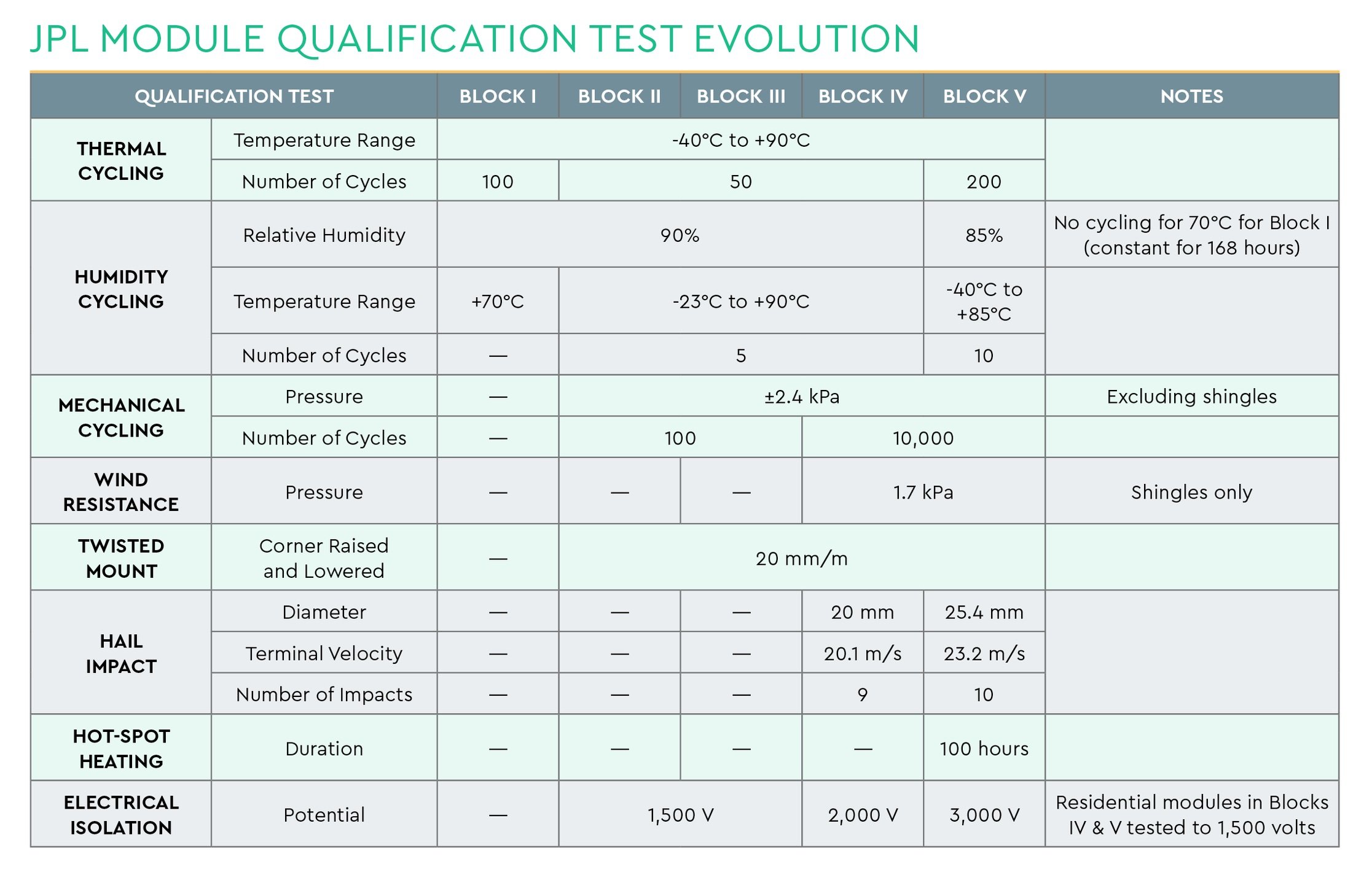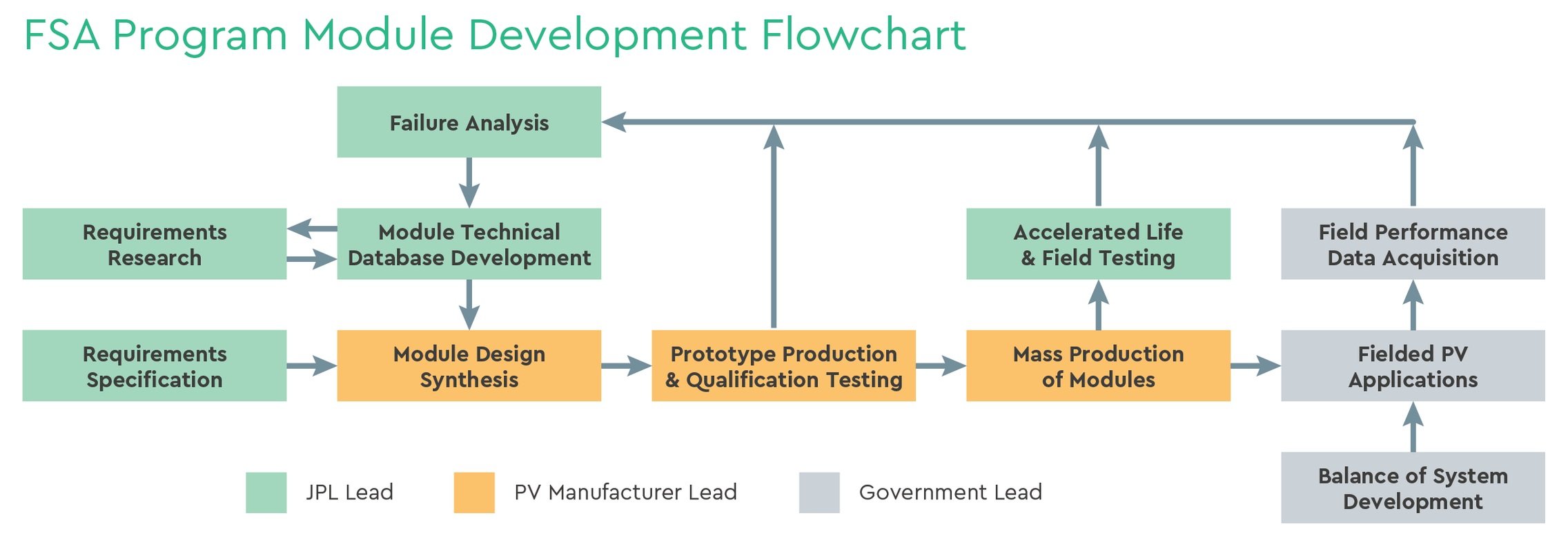Flat-Plate Solar Array Project
Funded by the U.S. government and led by the Jet Propulsion Laboratory (JPL) from 1975 to 1986, the FSA Project marks the genesis of the terrestrial solar market.
Photovoltaic (PV) module operational lifespans measured in decades are a testament to technological innovation—and rigorous testing programs. In the first of a series of articles about major milestones in PV module reliability and durability testing, RETC looks back at JPL’s ground-breaking work on the Flat-Plate Solar Array (FSA) Project.
JPL’s work on the FSA Project was foundational to the development of durability tests and performance standards that enable PV modules to withstand decades of field exposure. Analyzing probabilistic failure modes, project engineers defined design qualification tests still in use today. Moreover, contractor investigations led to the development of modern product and electrical safety standards.
BRINGING SPACE-AGE TECHNOLOGY DOWN TO EARTH
Describing the historical context of the time, the authors of a 1986 contractor report noted: “In the early 1970s, the pressures of increasing demand for electric power, combined with the uncertainty of fuel sources and ever-increasing prices for petroleum, led the U.S. government to initiate a terrestrial PV research and development (R&D) project. The objective was to reduce the cost of manufacturing solar cells and modules.”
In 1975, US government-sponsored work began in earnest to produce cost-competitive PV modules capable of supporting a large-scale terrestrial solar market. At the time, state-of-the-art PV modules, which cost more than $200/watt (in 2022 dollars), had a conversion efficiency of 5%–6% and an operational life of 1–2 years. By comparison, today’s high-performing commercial PV modules, which cost less than 0.40/watt, have a conversion efficiency of 22%–23% and an expected useful life of 30–40 years.
These dramatic improvements in PV module prices (>99.8% decrease), performance (>267% increase), and lifespan (>1,400% increase) are not simply the result of continual technological improvements related to cell technologies and module manufacturing. In parallel, industry stakeholders have used analytical approaches pioneered by JPL to identify in-field failure modes and quantify warranty risk prior to mass market adoption.
A decade after JPL first deployed PV power on the moon, its scientists led U.S. efforts to make flat-plate solar cost effective in terrestrial applications. [See NASA.]
ADVANCES IN ENGINEERING SCIENCES AND RELIABILITY
To facilitate the development of long-life PV modules that would perform cost-effectively in future large-scale power generation applications, JPL quantified the environmental stresses associated with two or three decades of field exposure. Subject matter experts also developed detailed application-specific module functional requirements and reviewed long-term operations and maintenance (O&M) considerations.
Based on these investigations, the JPL-led team defined, among other things, module hail impact probabilities, cell and module operating temperatures, humidity and soiling levels, ultraviolet exposure, and wind-pressure loading. While long-term empirical and field data may have been lacking, scientific rigor was not. After all, JPL’s scientists also pioneered the use of satellites and surveyors for space exploration.
Applying reliability-physics principles, the FSA Project defined prototypical design standards and analytical test methods that are still in use today. Critical areas of investigation included: interconnect fatigue; optical surface soiling; hail-impact resistance; glass- and cell-fracture strength; cell and module temperature-humidity endurance; hot-spot heating; bypass diode reliability; electrical insulation breakdown; and, electrochemical erosion.
The FSA Project is the origin of stress test sequences still in use today. [See JPL.]
ADVANCES IN MODEL CODES AND STANDARDS
In parallel with JPL’s foundational work on PV module reliability and durability, subject matter experts reviewed the adequacy of building codes, electrical safety, product safety standards, and standard construction practices. Identifying gaps related to the always-on and current-limited nature of photovoltaic devices, the team engaged Underwriters Laboratories (UL) to develop product safety construction requirements and detailed design concepts for safe systems.
UL’s investigations resulted in the publication of model codes and standards that remain relevant today. Based on UL’s research, the 1984 edition of the National Electrical Code introduced Article 690, Solar Photovoltaic Systems. By the end of the contract period, UL also published Document 1703, detailing the requirements for listing PV modules for electrical safety.
Fire-resistant module designs and materials are a legacy of the FSA Project. [See JPL.]
LESSONS LEARNED FROM THE FSA PROJECT
The impetus for the FSA Project will resonate with anyone reading today’s headlines with trepidation. Some fifty years may have passed, but concerns about energy security in the face of global instability remain top of mind. Then, as today, the strategic potential of widespread solar power adoption stood out as a promising path to a brighter future. However, what may have seemed like science fiction in the 1970s is now science fact.
The era of grid parity has arrived. Scientists at JPL launched America’s first satellite, achieved the first moon landing, and were the first to flyby or orbit other planets in the solar system. They also estimated the solar module cost reductions required to support mass adoption in terrestrial applications and displace other power generation sources.
According to the authors of JPL’s contractor report: “[In] 1975, the costs were still much too high for widespread use on Earth. It was necessary to reduce the manufacturing costs of solar cells by a factor of approximately 100 [emphasis added] if they were to be a practical, widely used terrestrial power source.”
Adjusted for inflation, PV module costs were $200/watt in 1975. By 2012, PV module costs in the U.S. crossed under the $2/watt threshold in all market segments. At the system level, costs for utility-scale and commercial solar projects have been less than $2/watt since 2014 and 2016, respectively. Today, solar is the leading source of new U.S. power generation capacity.
Lab testing improves in-field reliability. Achieving high-reliability, long-life PV module designs requires a strong reliance on extended test sequences conducted in a laboratory setting. By systematically identifying failure mechanisms, accelerated stress testing sequences, and allowable failure levels, the JPL team was able to steadily improve c-Si PV module lifespans over the course of the FSA Project.
In 1975, PV module warranties were nonexistent; though manufacturers designed PV modules with 5-year service life in mind, many failed prematurely after only one or two years of field exposure. By 1985, most PV modules carried a 10-year warranty and many operated successfully in field applications for 20 years or more. Informed by the pioneering work on the FSA Project, today’s PV modules have a useful life expectancy of 30 to 40 years and are warrantied by manufacturers accordingly.
JPL used accelerated life testing to identify PV module design vulnerabilities. [See JPL.]
Reliability testing must be cost-effective. A final takeaway from the FSA Project’s pioneering work on PV module testing was a recognition of the need for cost-optimized testing programs. On the one hand, testing to failure is too expensive and time consuming to support the needs of a market characterized by rapid growth and technological innovation. On the other hand, qualification and safety tests, though highly cost-effective, characterize initial short-term durability only.
In a paper presented at the 2013 IEEE PV Specialists Conference, Gerald Ross reflected on lessons learned from JPL’s FSA Project: “[Long-term life tests] must generally proceed systematically as part of an integrated research effort, as opposed to being part of a product development cycle. A key advantage of this type of testing is that it provides data to support life predictions.” It does not, however, address the real-time needs of project sponsors and insurers.
In his summary remarks, Ross presciently concluded that while current-day crystalline silicon (cSi) PV modules have much in common with their 1980s precursors, “new module materials and processes will require a diligent reliability program involving evaluation, testing, and the development of new solution techniques unique to the attributes and peculiarities of today’s technologies.”
In the next installment in this article series, RETC takes a closer look at another milestone in PV reliability testing—the development of the Thresher Test Protocol, the first-ever commercial reliability and durability test standard for c-Si modules.
Built in 1980, the Carlisle House, shown here in an artist’s rendering, was the first U.S. residence with a utility-interactive PV power system. [See DOE.]





